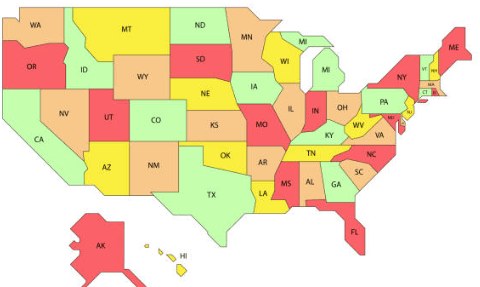Simple:Rkxzam4rq3i= Map of the Us

The Simple:Rkxzam4rq3i= Map of the U.S. stands out as a comprehensive tool that enhances users’ understanding of geographical and logistical intricacies across the nation. Its interactive features not only facilitate the exploration of state boundaries and key landmarks but also significantly aid in strategic planning for various sectors, including logistics and environmental assessment. As we examine its key functionalities and the unique advantages it offers over traditional mapping tools, several compelling questions arise regarding its implications for urban development and beyond.
Key Features of the Map
The map of the United States is characterized by distinct features, including the delineation of state boundaries, major geographical landmarks, and significant transportation networks. All of these elements facilitate a comprehensive understanding of the nation’s spatial dynamics.
Scale representation plays a critical role in accurately depicting these geographical landmarks. It ensures that distances and relationships between features are clearly communicated for informed navigation and analysis.
see also: Simple:I8puk4tikqu= Waves
Benefits for Users
Users can leverage the map of the United States to enhance their understanding of regional characteristics, optimize travel routes, and facilitate strategic planning across various fields such as logistics, urban development, and environmental assessment.
The map promotes user engagement through interactive features, while ensuring user accessibility by providing crucial data for informed decision-making.
Ultimately, this empowers individuals and organizations to navigate complex geographic landscapes effectively.
Comparison With Other Tools
Comparing the map of the United States with other geographic tools reveals distinct advantages in terms of detail, interactivity, and user engagement, which are critical for effective spatial analysis and decision-making.
A competitive analysis indicates that enhanced user experience significantly influences data interpretation, allowing for more informed decisions.
These features empower users, promoting a sense of autonomy in navigating complex geographical information.
Conclusion
In summary, the Simple:Rkxzam4rq3i= Map of the U.S. stands as a digital atlas, illuminating the intricate tapestry of state boundaries, landmarks, and transportation networks.
Its accurate scale acts as a compass, guiding users through the landscape of regional dynamics and strategic planning.
By fostering user engagement and supporting environmental assessments, this map emerges as an indispensable tool, akin to a lighthouse in the fog, enhancing decision-making processes in spatial analysis and urban development.




